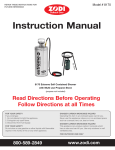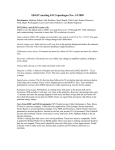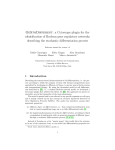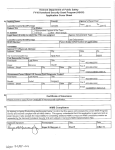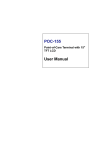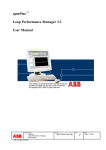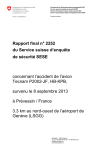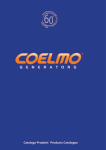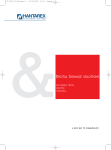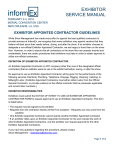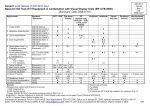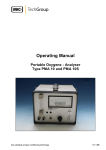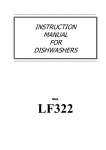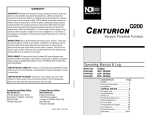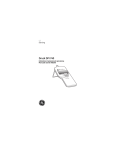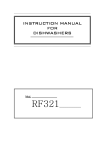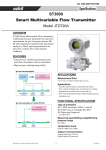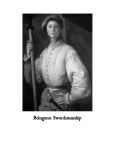Download CIRA-CF-09
Transcript
DISTRIBUTION STATEMENT NATURA DOCUMENTO RISTRETTO ARCHIVIO DOCUMENT NUMBER: REV.: CIRA-CF-09-1144 1 PROJECT PROGETTO COND_LMSA PROGRESSIVO DI ARCHIVIO /CIRA/PTUN JOB COMMESSA 3090510000 NO. OF PAGES WP 9051 DELIVERABLE 3+16 0047 TITLE CIRA PT-1 USER MANUAL PREPARED PREPARATO REVISED VERIFICATO APPROVED APPROVATO Izzo Carmelo (PTUN) Izzo Carmelo (PTUN) Izzo Carmelo (PTUN) DATE/DATA DATE/DATA 14/09/2009 14/09/2009 DATE/DATA 14/09/2009 AUTHORIZED AUTORIZZATO Vecchione Ludovico (SIAE) DATE/DATA 14/09/2009 BY THE TERMS OF THE LAW IN FORCE ON COPYRIGHT, THE REPRODUCTION, DISTRIBUTION OR USE OF THIS DOCUMENT WITHOUT SPECIFIC WRITTEN AUTHORIZATION IS STRICTLY FORBIDDEN A NORMA DELLE VIGENTI LEGGI SUI DIRITTI DI AUTORE QUESTO DOCUMENTO E' DI PROPRIETA' CIRA E NON POTRA' ESSERE UTILIZZATO, RIPRODOTTO O COMUNICATO A TERZI SENZA AUTORIZZAZIONE I DOCUMENT NUMBER: REV.: CIRA-CF-09-1144 1 TITLE: CIRA PT-1 USER MANUAL ABSTRACT: The present document describes the characteristics and the procedures of the CIRA Transonic Wind Tunnel PT-1. The PT-1 performance and the main dimension are described. The PT-1 auxiliary systems have been described. The time schedule requirements and the support requirement have been also outlined in order to give a guideline to PT-1 test organization and facility reservation. Furthermore the CIRA location and nearest lodging options have been presented. AUTHORS: Izzo Carmelo;Martire Luigi APPROVAL REVIEWERS: Izzo Carmelo APPROVER Izzo Carmelo AUTHORIZATION REVIEWERS: Vecchione Ludovico AUTHORIZER Vecchione Ludovico II DOCUMENT NUMBER: REV.: CIRA-CF-09-1144 1 DISTRIBUTION RECORD: DEPT NAME * DEPT NAME * Gruppo Ptun SIAE Vitiello Domenico SIAE Melluso Pasquale * PT = PARTIAL A = ALL III DOCUMENT NUMBER CIRA-CF-09-1144 IDENTIFICATIVO REV. 1 REVISION LIST LISTA DELLE REVISIONI REV. DESCRIPTION DATE EDITOR 0 Sostituisce CIRA-UM-04-300 09/09/2009 C. Izzo 1 Aggiornata Lista Contact Point 14/09/2009 C. Izzo CIRA-CF- 09-1144 PT1 USER MANUAL SUMMARY 1.0 INTRODUCTION...........................................................................................3 2.0 LIST OF ACRONYMS...................................................................................3 3.0 FACILITY DESCRIPTION.............................................................................3 3.1 4.0 4.1 GENERAL DESCRIPTION....................................................................................3 TUNNEL OPERATION .................................................................................4 PT-1 AERODYNAMIC PERFORMANCE.............................................................4 5.0 TEST SECTION DETAILS ............................................................................5 6.0 FAN SYSTEM ...............................................................................................6 7.0 COOLING SYSTEM......................................................................................6 8.0 INSTRUMENTATION....................................................................................6 8.1 WAKE RAKE ........................................................................................................6 8.2 PRESSURE MEASUREMENT INSTRUMENTATION.........................................7 8.3 OTHER INSTRUMENTATION.............................................................................8 8.4 VIRTUAL INSTRUMENTATION .........................................................................9 8.5 IMAGING CAPABILITY.......................................................................................9 8.6 MODEL SUPPORT SYSTEM (MSS) .....................................................................9 8.7 INTERNAL BALANCES .......................................................................................9 8.7.1 3 Component Strain Gage Balance Characteristics ..............................................9 8.7.2 6 Component Strain Gage Balance Characteristics ............................................10 9.0 9.1 9.2 9.3 10.0 10.1 10.2 AUXILIARY SYSTEMS ...............................................................................10 AIR SUPPLY SYSTEM........................................................................................10 CIRCUIT EXHAUST ...........................................................................................11 PLENUM EXHAUST ...........................................................................................11 FACILITY MANAGEMENT SYSTEM..................................................11 TUNNEL CONTROL SYSTEM ...........................................................................11 DATA ACQUISITION AND ELABORATION SYSTEM ....................................12 11.0 COMPUTER PLATFORM...........................................................................13 12.0 TEST GENERAL ARRANGEMENT ...........................................................13 13.0 PT-1 OPERATING TEAM ...........................................................................13 14.0 PERSONNEL SAFETY ISSUES.................................................................13 14.1 14.2 HAZARDS............................................................................................................13 PROTECTIVE EQUIPMENTS.............................................................................14 Page 1 of 15 CIRA-CF- 09-1144 PT1 USER MANUAL 14.3 EMERGENCY PROCEDURES............................................................................14 15.0 CIRA SITE LOGISTIC.................................................................................14 16.0 PT-1 TEST REQUEST PROCEDURE ........................................................14 17.0 CONTACT POINT.......................................................................................14 18.0 REFERENCES............................................................................................15 Page 2 of 15 CIRA-CF- 09-1144 PT1 USER MANUAL 1.0 INTRODUCTION Since September 1998 CIRA, the Italian Aerospace Research Centre, has entered into operation a Transonic Wind Tunnel PT-1 with the aim to support industrial and research programmes with a versatile and high flow quality aerodynamic testing platform, over a wide speed range, for a variety of small scale test articles. In May 2000 CIRA has been granted membership in the Supersonic Tunnel Association, International (STAI). This document describes the wind tunnel technical characteristics and performances, its instrumentation and the typical operative procedures. The CIRA PT-1 is equipped with complete tunnel instrumentation for aerodynamic measurements. CIRA test engineers are available for measurement support and data interpretation. Nevertheless customers are free to operate, within their individual agreement with CIRA, their own instrumentation. The facility is located in Capua (CE), Italy about 50 km north of Naples. The Transonic Wind Tunnel is part of a brand new complex which includes ground testing facilities and dedicated service utilities making up the Italian Aerospace Research Centre. The picture in Fig.1 shows a view of the facility. 2.0 LIST OF ACRONYMS CIRA CL CS DAS FMS System HX HW PT-1 MSS SW TS UPS Supply V VI WT Centro Italiano Ricerche Aerospaziali Wind Tunnel Centre Line Cooling System Data Acquisition System Facility Management Heat Exchanger Hardware Pilot Tunnel 1 Model Sting Support Software Test Section Uninterruptable Power Velocity Virtual Instrumentation Wind Tunnel 3.0 FACILITY DESCRIPTION 3.1 GENERAL DESCRIPTION The Transonic Wind Tunnel PT-1 is a closed-circuit, pressurised wind tunnel. A sketch of the PT-1 functional layout is shown in Figure 2. Fig.2: Transonic Wind Tunnel PT-1 functional layout Fig. 1: Transonic Wind Tunnel PT-1 – General Overview The PT-1 has two drive systems: a fan, for continuous subsonic tests, and an air compressed system, for intermittent transonic and supersonic tests. The facility is equipped with two nozzle blocks: a convergent nozzle, for Mach numbers below 1.1, including fan continuous operations, and a convergent-divergent nozzle for intermittent operations at M = 1.4. Page 3 of 15 CIRA-CF- 09-1144 PT1 USER MANUAL Two test sections are available: one with solid walls for subsonic tests, and the other one with perforated walls for transonic tests. Both the test sections have top and bottom adjustable walls (α= + 0.5 deg.). Lateral wall inserts for 2D and half - model testing are also available. The inserts are equipped with bottom and side walls optical windows for flow visualization tests. Up to the 3% of the injected mass flow is removed through a plenum exhaust system, whereas the remaining 97% is removed through a circuit exhaust system. In this way, it is possible both to control the speed at high Mach numbers (M > 0.8) and to achieve the desired flow qualities in the test section. In the Mach number range between 0.4 and 0.8 the test section speed is controlled via the 2nd throat, located downstream the test section. Furthermore, Mach trim flaps allow performing a fine control of the Mach number. The 2nd throat and a set of acoustic baffles allow reducing the noise level in test section. Finally, the facility is equipped with two data acquisition systems, dedicated to the control of the facility parameters and to the acquisition of pressures, temperatures and other analog signals. The control room equipment includes the video camera monitors, operator console and the engineering and data acquisition hosts which provide complete information about the test and model conditions. A dedicated area is available for model preparation 4.0 TUNNEL OPERATION The maximum speed achievable in the IWT depends upon the selected configuration. The maximum stagnation pressure at which the tunnel may be operated is 1.75 bar. The Mach number is variable from 0.4 to approximately 1.05 using convergent nozzle blocks. Operation at Mach 1.4 is achieved using convergent/divergent nozzle blocks. For Mach numbers from 0.4 to approximately 0.8 Mach number is controlled using the second throat and the Mach trim flap on the second throat centerbody. For Mach numbers between 0.8 and 1.05 and at Mach 1.4, Mach number is controlled by varying plenum pressure using the plenum exhaust flow system with the second throat at a fixed position. While subsonic operation is in continuous mode, the transonic and supersonic operation is intermittent with a maximum run time of about 130 sec. 4.1 PT-1 AERODYNAMIC PERFORMANCE Fig.3: PT-1 Control room The WT circuit is located in a building that hosts the operating team and users offices and the facility control system room (Fig.3). In the transonic and the supersonic tests, the test section wall angles have been set to a diverging angle of 0.25 deg., to control the boundary layer growth along the walls. The main performance parameters of the PT-1 wind tunnel have been included in tab. 1. Fig. 4 shows the operating envelope of the wind tunnel in terms of achievable Mach & Reynolds for both 3D and 2D models. Reference lengths are 10% of the square root of the test section area and a 2D chord of 10 cm.Fig. 5 Page 4 of 15 CIRA-CF- 09-1144 PT1 USER MANUAL shows the Mach-P0 envelope with Reynolds curves for the 2D reference length. 1.15 1.10 1.05 1.00 0.95 Mach Number 0.90 3.500.000 q = 2.500 [Pa] q = 10.000 [Pa] q = 25.000 [Pa] q = 50.000 [Pa] Lref (3D) = 0,040 [m] Re 3.000.000 q = 5.000 [Pa] q = 15.000 [Pa] q = 30.000 [Pa] q = 60.000 [Pa] q = 7.500 [Pa] q = 20.000 [Pa] q = 40.000 [Pa] Lref (2D) = 0,1 [m] 0.85 0.80 0.75 0.70 0.65 0.60 Model Length 0.55 2.500.000 Rotation Centre 0.50 0.45 2.000.000 0.40 0 100 200 300 400 500 Test section length (mm) 1.500.000 1.000.000 Fig. 6: Empty tunnel Mach longitudinal distribution 500.000 0 0,0 0,1 0,2 0,3 0,4 0,5 0,6 0,7 0,8 0,9 1,0 1,1 1,2 M 1,3 1,4 1,5 Fig. 4: PT-1 operating envelope – Reynolds vs. Mach number 5.0 180 Po [KPa] 170 160 150 140 130 120 110 100 Lref = 0,1 [m] Re = 1.250.000 Re = 2.250.000 90 Re = 500.000 Re = 1.500.000 Re = 2.500.000 Re = 750.000 Re = 1.750.000 Re = 2.750.000 Re = 1.000.000 Re = 2.000.000 Re = 3.000.000 80 0 0,1 0,2 0,3 0,4 0,5 0,6 0,7 0,8 0,9 1 1,1 M 1,2 1,3 1,4 number 1,5 Fig. 5: PT-1 operating envelope – Total pressure vs. Mach number TEST SECTION DETAILS The facility is equipped with two test sections, one for subsonic tests and the second for transonic/supersonic tests with perforated walls (60° inclined holes, 6.3% porosity). Both test sections have floor and ceiling adjustable walls (α = + 0.5 deg.) In the intermittent injection-driven operation mode, the Mach number set point is in the range between 0.4 and 0.8, reached via the 2nd throat adjustment, while for higher Mach numbers the set point is reached via mass flow removal (up to 3% of the overall circuit mass flow) on the test section perforated walls. The different test section features are listed in Tab. 1. The Mach number distribution in the empty test section has been measured during facility calibration using a centreline static pipe. The mach distribution is shown in fig. 6. Fig. 7: Solid wall test section Page 5 of 15 600 CIRA-CF- 09-1144 PT1 USER MANUAL Test section Parameter Size (w,h,l) Subsonic Transonic / Supersonic 350x450x600 350x450x600 Walls Solid Perforated 6% porosity Contraction ratio 10:1 10:1 Mach number 0.1 - 0.37 0.35 - 1.1 1.4 Tab. 1: Test section features Test sections are equipped with lateral inserts for 2D and half-model testing. The 2D TS insert provides the means to gain aerodynamic data from articles spanning between the side walls. Three assemblies form the mechanical hardware: one far and one near side wall assembly (nearest respectively furthest to the control room) plus one floor assembly. Each of the side wall assembly consists of a rigid base frame to which a turn table together with a machinery and drive components is attached. 6.0 FAN SYSTEM The fan (Fig. 8) provides the motive power to the wind tunnel during continuous subsonic operations at Mach numbers up to 0.4. It is connected to an 132 kW external drive motor, and has both continuous adjustable blade pitch and variable speed (n max = 3000 rpm), in order to achieve the most efficient layout over the entire subsonic Mach range. During transonic operations with the injector drive system, the rotor blades ere locked in a fixed position to perform tests of the optimum operating conditions which minimizes losses through the fan. Fig. 8: Fan Unit and injectors system The wind tunnel speed is automatically controlled via the Facility Management System (FMS). 7.0 COOLING SYSTEM The Cooling System (CS) function is to remove the heat generated by the fan during continuous operations. Cooling water flow is variable, up to 5 lt/s. A heat exchanger dissipates the energy delivered to the stream by the wind tunnel drive fan. The heat exchanger is designed for low pressure loss, spatially uniform flow and small variations in bulk air temperature across its face. The main characteristics of the heat exchanger are: - 8.0 Water inlet temperature: 12.8°C Water flow rate: 3.01l/sec(2.11) Removed heat: 50 kW INSTRUMENTATION 8.1 WAKE RAKE A wake rake for drag measurement in the CIRA transonic wind tunnel PT-1 has been designed and realised for 2D airfoil characterisation. The PT-1 wake rake system consists of a main rear support, a central body and a fore part, together resulting in the complete “long” configuration. By omitting the central body, the “short" configuration Page 6 of 15 CIRA-CF- 09-1144 PT1 USER MANUAL is obtained, corresponding to the maximum allowable rear position (Fig. 9). Fig. 9: “Long” and “Short” configurations Central body is an interchangeable interface element between the fore body and the rear support. By substituting (with a new piece) or omitting this part it is possible to vary the longitudinal position of the probe array. Central body can be installed or removed from the wake rake system without removing probe connection tubes. A removable cover panel located on one side, in the central zone, allows the access to the central internal vane, provided for tube driving. Rear support and fore body are the base elements of the wake rake system. Rear support is the interface with wind tunnel arc sector support system; its shape has been designed in order to satisfy the installation requirement, and reproduces, where possible, the existing conical arc sector. The fore body is the core of the wake rake system, designed to allow the installation of 64 total pressure probes and four supports for static pressure probes. It consists of 3 subcomponents, 2 of them fixed together after machining and resulting in a “main fore element”; the third one is a removable cover element allowing the access to the internal cavity. Fore body central zone has a cuneiform shape, varying from a rectangular rear end section 16 mm wide, to a forward section with a 3.0 mm diameter rounded shape. Top and bottom fore zones have a rectangular longitudinal section, 6.0 mm thick; an internal cavity 2.0 mm wide has been provided, corresponding to the minimum dimension that allow the installation of total pressure probes and the routing of the relevant connection tubes. The need for a larger central zone stems from the necessity to install 46 Pitot probes: 21 of them are placed along the central longitudinal section, 19 along 2 lines placed symmetrically at a distance of 2.5 mm from the central section, and 6 along 2 more lines placed symmetrically at a distance of 5 mm from the central section. The pitot probe distribution allows to capture the whole wake event at incipient stall conditions. Fig. 10: Wake Rake Installed on PT-1 model support system – “long” configuration 8.2 PRESSURE MEASUREMENT INSTRUMENTATION Pressure is the main parameter measured in PT-1. The facility is equipped with two pressure measurement systems. Page 7 of 15 CIRA-CF- 09-1144 PT1 USER MANUAL The first system is part of the Master Control System (MCS), dedicated to the control of the facility. This system is equipped with two absolute pressure transducers, for the measurement of total pressure in stilling chamber and static pressure in plenum chamber, and two differential pressure transducers, to measure dynamic pressures. The table 2 shows the characteristics of these transducers which are critical to assess the facility operation condition. Parameters from those transducers may be used for understanding of the aerodynamic process inside major facility components. Measured Parameter FS (Bar) Accuracy %F.S. Abs.Error (Bar) Total pressure in stilling chamber 2 0.05 1E-3 Static pressure in plenum chamber 2 0.05 1E-3 Dynamic Pressure (low range) 0.35 0.05 2E-4 Dynamic Pressure (high range) 1.4 0.05 7E-4 Tab. 2: MCS characteristics Pressure Measured Parameter FS (PSI) Accuracy %F.S. Abs. Error (Bar) Mode Pt and PS in stilling chamber 30 0.05 1E-03 Differential Ps on the centerline 15 0.05 5E-04 Differential Wall static pressures 30 0.05 1E-03 Differential Ambient pressure 45 0.01 3E-04 Absolute Tab. 3: PSI 8400 pressure transducers characteristics Transducers The second system is the PSI 8400, manufactured by Pressure System. PSI 8400 is part of the test data acquisition system. Pressures data collected duringA run may be acquired by means of the PSI 8400 (Fig. 11). The pressure transducers characteristics are shown in tab. 3. Fig. 11: PSI 8400 system 8.3 OTHER INSTRUMENTATION Other available instruments characterization are: − − for flow Hot Wire Flow Angularity Probe Page 8 of 15 CIRA-CF- 09-1144 PT1 USER MANUAL 8.4 VIRTUAL INSTRUMENTATION In case necessary for a specific test, other instruments can be connected to FMS system. The FMS will recognize these instruments as Virtual Instruments (VI). Particularly, the connection can be performed linking physically and logically the instrument to Data Acquisition System. The logical link is performed to the Virtual Instrument Communicator Task, which is located on Data Acquisition Host. 8.5 IMAGING CAPABILITY Fig. 12: rear sting model support system The test performed can also be documented by means of video and still imaging reporting. Both optical and digital imaging may be recorded during or after the run. Two video cameras are positioned inside the plenum, looking at the model from different viewpoints. The video image is displayed on the monitors in the control room. Different recording formats are available. Particular customer request can be discussed during the meetings before the test. A new motorized model support system is going to be installed soon. A pictorial view is provided in the following fig. 13. This system has been entirely design by CIRA. 8.6 MODEL (MSS) SUPPORT SYSTEM The Model Support (Fig. 12) consists of an arc sector with a sting pod that can be manually positioned at pitch angles of 0°, +/-2°, +7.5° and 15°. Both the arc sector itself and the leading edge of the arc sector are removable to allow testing with various geometries. The initial leading edge geometry is a 4 to 1 elliptical shaped nose and a 20° included angle taper. The sting pod has an instrumentation passage large enough to hold up to 50 pressure tubes and pass the tube directly into the strut. The pod may be connected to a sting for conventional model testing and to a 4 cm diameter centreline pipe for static pressure measurements. The following Fig. 13 shows the current model support system installed for a 3D test on an Unmanned Space Vehicle configuration. Fig. 13 – new motorized model support system 8.7 INTERNAL BALANCES 8.7.1 3 Component Strain Gage Balance Characteristics The 3C component balance has the following characteristics. Page 9 of 15 CIRA-CF- 09-1144 PT1 USER MANUAL Component name Symbol Full Scale Axial force Fx 240 N Normal force Fz 1500 N Pitching moment My 60 Nm The 3C balance has been designed and built in order to guarantee on each component a measurement accuracy of 0.1% of the relevant above listed full scale values. An overload capacity of 2 times load capacity has been provided. The 3C balance has been used in several test campaign. 8.7.2 6 Component Strain Gage Balance Characteristics The 6C component balance has the following characteristics. Component name Symbol Full Scale Axial force Fx 160 N Side force Fy 350 N Normal force Fz 1000 N Mx 9.0 Nm My 40.0 Nm Mz 30.0 Nm Rolling moment Pitching moment Yawing moment The 6C balance is designed in order to guarantee on each component a measurement accuracy of 0.1% of the relevant above listed full scale values. The balance has overload capacity of 2 times the load capacity. The following Fig. 14 shows the internal balance acquisition unit which has been designed and built at CIRA. Fig. 14: Internal balances acquisition unit 9.0 AUXILIARY SYSTEMS The auxiliary systems for PT-1 include the air supply system, circuit exhaust system and plenum exhaust system described in the following subsections. 9.1 AIR SUPPLY SYSTEM The air supply system provides air to drive the tunnel injector and the plenum ejector for intermittent operations in the transonic range. The system includes an air compressor system, high pressure air storage tanks and piping to deliver air to the injector nozzles and the plenum ejectors. The air supply system characteristics are: - - Pressure at injector: 17 bar (absolute) Maximum injector mass flow rate: 21 kg/sec Maximum plenum ejector flow rate: 5 kg/s Run time at Mach 1.4: 130 sec Minimum air temperature -10°C Maximum temperature excursion during a run: +/- 10°C from tunnel ambient Maximum storage repump time: 30 minutes Page 10 of 15 CIRA-CF- 09-1144 PT1 USER MANUAL 9.2 CIRCUIT EXHAUST The function of the circuit exhaust system is to remove the air added to the circuit by the injector. To overcome the aerodynamic losses in the piping and exhaust stack, the tunnel pressure at the exhaust location must be somewhat above ambient in order to be driven out of the circuit without the aid of external pumping. To accomplish this at the PT-1 transonic operation, the minimum tunnel pressure will be in the range from 1.25 to 1.5 bars. The actual value will be determined from the pilot test program. The circuit exhaust system control valves operate in a closed loop control mode. If the tunnel pressure rises above the set point, the valves open slightly as required to release pressure. If the pressure falls below the set point, the valves close slightly as required to gain pressure. The exhaust air is drawn out of the tunnel through a perforated section, collects in a plenum and flows through four exhaust ducts to the circuit exhaust stack. The exhaust system characteristics are: - Maximum mass flow rate: 21 kg/sec Maximum system pressure loss (control valves fully open): < 0.20 bars Exit pressure: 1.0 bars Minimum inlet pressure: to be determined from PT-1 operation 9.3 PLENUM EXHAUST The plenum exhaust system (PES) is used to extract up to 3% of the wind tunnel mass flow through the perforated walls of the transonic test section. The PES controls the test section conditions at transonic Mach numbers up to 1.05. The PES trims the test section conditions at Mach 1.4. Two symmetrically placed exhaust ducts are used, one on each side of the test section plenum, to reduce the impact of the plenum exhaust flow on the test section flow quality. Each exhaust duct contains a butterfly valve for controlling the plenum pressure using closed loop control. An ejector downstream of the control valves pumps the plenum exhaust to the exhaust stack at atmospheric pressure. The ejector is driven by the air supply system. The plenum exhaust system characteristics are: - Maximum wall flow removal rate: 1.9 kg/sec - Minimum plenum pressure: 0.47 bar - Maximum ejector primary flow: 4.73 kg/sec - Ejector primary air pressure: 15.4 bar 10.0 FACILITY MANAGEMENT SYSTEM The CIRA PT-1 wind tunnel is equipped with two systems managing data coming from the field: - Control System (CS) Data Acquisition System (DAS) MMI PC DAS PC ENG PC Manual Console Elsag Bailey Data Highway I/O Boads Dedicated Control System PSI Unit AI Boards Air Supply System Instrumentation Test Instrumentation Allen Bradley SLC500 PLC INFI90 DCS (3 Processors) I/O Boards Circuit Exhaust Instrumentation I/O Boards Facility Instrumentation PT-1 Wind Tunnel Fig. 15: Facility Management System 10.1 TUNNEL CONTROL SYSTEM CS gets data from the field in order to control the facility (see fig. 16). The Master Control System (MCS) is a digital control system which consists of a run console, servo controllers and instrumentation. The process is controlled by the MCS. The MCS includes a ELSAG BAILEY INFI-90 and LAN 90 control system. Page 11 of 15 CIRA-CF- 09-1144 PT1 USER MANUAL STORAGE THANKS Dedicated Controller INFI90 Controller INFI90 Controller Pressure INFI90 Controller Pressure Fan RPM Air Supply System Blade Pitch Position Injection System Ejection System EXHAUST DUCT Fan EXHAUST DUCT Venturi Plenum Exhaust SLC500 PLC INFI90 Controller Pitot Sensor Circuit Exhaust 2n d Throat Walls Test Chamber Mach Trim Flaps MTF and 2nd Throat Position operations of test and device configuration, on-line pressure transducers calibration, data acquisition recording and visualization. Furthermore, the integrator coordinates the entire process of model attitude positioning and data recording on event, for Pitch & Pause or Pitch Sweep test modes. In Fig. 17 the overall system configuration is illustrated. The integrated hardware devices are: INFI90 Controller Fig. 16: Diagram Control System functional The Control System has two types of control loops, that process control loops and the positioning control loops. Control loops are used to control the tunnel, injector and ejector pressures. Position control is used for second throat side walls and Mach trim flaps. Speed and blade pitch control is used for fan control. Tunnel fill control is used to pressurize the tunnel before running. Tunnel vent control is used to reduce the tunnel pressure. 10.2 DATA ACQUISITION ELABORATION SYSTEM AND The PT-1 Data Acquisition System (DAS) is fully dedicated to the Test Article measurements. DAS gets data related to the specific test to be performed in the wind tunnel; data will come either from the model in the test section or from the tunnel itself. For 2D testing, a modular integrated hardware has been designed and built. Three measurement systems and a turn table controller for the test article (model) attitude positioning have been integrated. Each of these devices is controlled by a software module, running on a PC called “controller”, that operates both as subsystem supervisors and data servers. Another software module, called “integrator”, running on a remote PC, is connected to each server PC through a LAN link and works as client of the different servers. The integrator centralizes, respect to the operator, the (a) An electronically pressure scanning system (PSI8400) which acquires about 250 pressure measurements on the model and on the wind tunnel internals. This system is connected to the controller PC through a IEEE488 link. (b) A high precision barometer (DPI740) for the precise measurement of the atmospheric pressure. This device is connected to the controller PC through a RS232 link. (c) A dual sensor (RUSKA6222) for high precision Mach number measurement. This device is connected to the controller PC through a RS232 link. (d) A computer based turn table system for model attitude positioning. This device is connected to the controller PC through a RS232 link. Fig. 17: PT-1 Data Acquisition System Configuration Page 12 of 15 CIRA-CF- 09-1144 PT1 USER MANUAL 11.0 COMPUTER PLATFORM The host hardware platform is based on a PC network running Microsoft Windows XP. The communication is assured by an 100 Mbit Ethernet LAN. The interface to the PLC based low-level control systems consists of an industrial Ethernet LAN. Moreover, the PT-1 computer network consists of the following PC: − − − File server Tunnel control host Test automation host of the following equipment: − − data acquisition Pressure System Balance System The following devices are also available: − − B/W Laser printer Video system All systems are fed through UPS supply. 12.0 TEST GENERAL ARRANGEMENT The facility in principle runs on a single shift of 8 hours per day but, on request, different working time can be contracted. The time required for a run is strongly affected by the measurements to be performed after the run. The PT-1 is charged on occupancy time basis with no regard to actual test conditions. No difference is made also for test or after run inspection, nor for configuration changes, when needed. The model preparation is normally made outside of the wind tunnel, in the model preparation room. Model preparation is usually quoted on fixed (time plus material) basis. CIRA can arrange for test model instrumentation and manufacturing if agreed with sufficient time in advance. Normal complexity models will require 6 months for design and construction by CIRA. Quotation can be given on request. Model supplied by customers shall be verified. A stress analysis report shall be performed including thermal stresses, dynamic stresses, cyclic stresses. Model and user instrumentation interfaces shall be clearly identified and agreed between PT-1 user and CIRA PT-1 test engineers. In case special parts are needed to accommodate actual interfaces either CIRA or PT-1 user can provide them as agreed during the test preparation meeting in the contractual phase. The customer are allowed in the control room with its own instrumentation and all cabling can be routed, through the shell penetration, to the model in the test section. The cable length for instrument connection shall be at least 12m. On request the use of computer with analysis SW can be arranged during the test session and, in general, CIRA test engineer are available for data interpretation and technical discussion. A test report, containing all the images, video and measurements performed will be issued at the end of the experimental activity for the customer. In case joint publications can be issued after the test campaign a reciprocal authorization will be signed for data communication to third parties. 13.0 PT-1 OPERATING TEAM The facility is operated and maintained by a dedicated support team which can be integrated with other specific competence currently available in CIRA . The department is currently hosting 3 Test Engineers, one Facility Operator, under supervision of a Laboratory Manager 14.0 PERSONNEL SAFETY ISSUES 14.1 HAZARDS Some potential hazards can be taken into account during test preparation and execution due to the variety of systems running in the PT-1 area. The main are listed below: Page 13 of 15 CIRA-CF- 09-1144 PT1 USER MANUAL − − − − − High pressure pipe Electrical shocks Laser light exposure Noise Mechanical hazards Suitable signs are located in critical areas, nevertheless PT-1 users are not allowed to operate any facility component. During the pre-test meeting the potential hazard will be showed and discussed. PT-1 users will also be informed about safety procedures before the test program start. 14.2 PROTECTIVE EQUIPMENTS Impact protection helmets and noise protection taps can be found in PT-1 building. Other personal equipment needed for workshop activities will not be provided by CIRA. The PT-1 users will be provided with their own personal protection devices such as working gloves, shoes, to be used for model mounting and assembly in the model preparation area. 14.3 EMERGENCY PROCEDURES The CIRA emergency procedure will be showed to PT-1 users. All necessary protection devices will be provided to guests care of CIRA. If required, all people in the PT-1 area shall follow CIRA team safety responsible instruction. 15.0 CIRA SITE LOGISTIC CIRA is located in Capua, a small town near Naples and Caserta, located at about 200 kilometers south of Rome and about 50 Kilometers North of Naples. Customers can arrange their trip to CIRA with a flight either to Rome (Fiumicino Airport) or to Naples (Capodichino Airport). 16.0 PT-1 TEST REQUEST PROCEDURE To perform tests in PT-1 a formal request has to be submitted, at least one year in advance of the scheduled date for testing, to CIRA. The request, including the target test period, number of runs, type of experiment, test article description and the measurement to be performed will be examined and a preliminary meeting should be organized to discuss the test detail and scheduling. Within one month from the meeting the test program detail and scheduling will be defined and a Statement Of Work (SOW) will be submitted to the PT-1 user along with the related project cost. After the PT-1 test contract formalization and signing by both parties the preparatory work can be scheduled between CIRA PT-1 engineer and the customer. During this test preparation activity one or more meeting will be dedicated to : − Test plan definition − Model mounting detail − Instrumentation definition and related connection − PT-1 configuration − Auxiliaries system requirements − Data acquisition and reduction At least 6 moths in advance the PT-1 user shall supply to CIRA all the detail about the model mounting interface and necessary connection as well as the report on the stress analysis and electromagnetic compatibility. If model design and construction has been assigned to CIRA a design review meeting will be organized, at the same date, to freeze the model configuration. Two weeks before the scheduled test date the PT-1 user shall deliver to CIRA the test model, its instrumentation and all the relevant interface. A list of user personnel attending test preparation and/or execution shall also be sent to CIRA for PT-1 area entry permit preparation. 17.0 CONTACT POINT The CIRA mail address is: Page 14 of 15 CIRA-CF- 09-1144 PT1 USER MANUAL CIRA scpa Via Maiorise s.n.c. 81043 Capua (CE) ITALY 5. D’Alessandro The CIRA responsible for Aeronautical Ground Test Facilities is: 6. Fauci R., Imperatore B., “Technical Ing. Ludovico Vecchione Phone: +39-0823-623918 Fax : +39-0823-969272 E-mail: [email protected] L., “Descrizione del sistema Acquisizione Dati della Galleria del Vento Transonica Pilota” - MC-3CCIRA-7-MO-0029 Specification for Design and Realisation of CIRA USV FTB1 3D Scaled Models and the Related Test Equipments For Tests in CIRA PT-1 Transonic Wind Tunnel” - CIRA-TS-02-108 The CIRA responsible for PT-1 Wind Tunnel is Ing. Carmelo Izzo Phone: Fax : E-mail: +39-0823-623013 +39-0823-969272 [email protected] Secretary Fax : +39-0823-623963 +39-0823-969272 CIRA Operator +39-0823-623111 CIRA entrance desk: +39-0823-623001 18.0 REFERENCES 1. Ferrigno F., Fusco F., Manco M., De Matteis P., “CIRA Transonic Wind Tunnel PT-1 Performance Analysis” – CIRA-TM-LAS-99-175. 2. Ferrigno F., Manco M., Ragni A., “Transonic Wind Tunnel Aerodynamic Commissioning” – MC-3C-CIRA-7-TN0074 3. Fauci R., Imperatore B., “Design, Realisation and Performance Evaluation of a High Accuracy Wake Drag Measurement Device for Cira Transonic Wind Tunnel” 4. Inverno M., Fusco F., “A PC-Based Data Acquisition System Supervisor” International Congress on 19th Instrumentation in Aerospace Simulation Facilities (ICIASF’01) – CIRA-TN-01-0156 Page 15 of 15



















